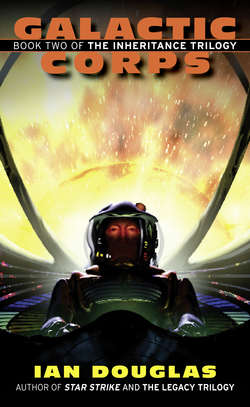Читать книгу Galactic Corps - Ian Douglas, Matthew Taylor - Страница 23
UCS Hermes Stargate Carson Space 0748 hrs, GMT
Оглавление“Four more fighters coming through, General,” Colonel Macalvey reported, his voice tight with excitement. Every remaining MIEF fighter was in space, now, swarming about the incoming Xul hunterships as they drifted in an immense and untidy clot at the center of the stargate. “Tough to see them in all that crap.”
Alexander didn’t reply. The debris cloud in front of the stargate was so thick now that it was tough to see anything, but three of the fighters were broadcasting their transponder signals at full intensity—hoping to ward off so-called friendly fire as they came into the kill zone—and battlespace drones emplaced on the stargate ring itself were picking up and boosting those signals. The transmissions revealed the tightly grouped icons of three … no, four Wyverns flying scant meters off the inner side of the stargate’s ring as they streaked through into Carson Space.
Good. A few more Marines had made it back. …
And with them came a burst of signal-boosted telemetry, updating the battlenet. Alexander felt the stream of raw information flowing into Hermes’ computer network. From the little he could grab, unanalyzed, Bloodlight had exploded on the other side, though not as soon as, and not with the violence, expected. As soon as the data were downloaded, the science team AIs would be fine-combing it, updating the available information on Xul warships coming through the gate.
The big question, of course, was whether the violence of the exploding star had damaged the enemy vessels, hurt them enough to stop them from coming through into Carson Space.
So far, the battle was going well, and at least vaguely according to plan. In any battle, the key determining factor is the terrain. Open space has no terrain, and tactics must be dictated by the relative technology possessed by the combatants, and by numbers.
The stargate, however, impressed a type of terrain on battlespace, a bottleneck, specifically, that allowed only a few ships to pass from one side to the other at a time, and that only slowly. In open space, the Xul possessed staggering advantages in technology and firepower, but the stargate bottleneck allowed Admiral Taggart to mass the weaponry of the entire MIEF against a single, tiny area and focus it all on the Xul ships as they passed through into the Carson Space kill zone.
That kill zone was visible now, even to the unaided eye, as a thick fog and a tangle of wreckage adrift in front of the Carson stargate. As volley upon volley of high-energy beam weapons gutted each Xul ship coming through the gate, gouts of internal gases and molten hull material erupted into space, freezing in seconds into glittering droplets and creating a dense haze. Nuclear and antimatter warheads added expanding spheres of hot plasma to the haze, and throughout were tangled bits of debris, much of it still glowing white-hot.
The stargate was twenty kilometers across, and already the nebula of debris covered a volume of space much wider than that. It was actually becoming difficult to see what was going on at the cloud’s center. The radiation there was intense enough to scramble most sensors, though the ring-emplaced sensors were still doing a good job of spotting most of the stuff coming through.
The Xul warships continued to emerge, visible only as large shapes half-glimpsed through the debris cloud. They were coming through at low speed—at eighty to ninety kilometers per hour—and colliding with the drifting wreckage. While they weren’t moving fast enough to cause significant damage to their outer hulls with the collisions, they appeared to be disoriented, as though they weren’t expecting space to be so crowded with wreckage and debris.
Fire continued to rain down upon each in turn, tearing great gashes in ceramic-metal hull material that glowed red and orange with the intensity of the bombardment. The space in front of the stargate pulsed and strobed with the silent flashes of detonating antimatter warheads, and the debris haze was thick enough that plasma bolts and laser beams had become visible to the unaided eye, illuminated by the trails of vaporizing particles of dust and ice.
Those Xul warships that worked their way clear of the man-made nebula found themselves at the focus of long-range bombardment from nearly one hundred Commonwealth warships, and by the short-range jab and sting of Marine aerospace fighters.
Over the past twenty minutes, the battle had slowly transformed into a slaughter. From his vantage point, he could watch the Xul craft emerge from the gate, struggle to orient themselves, and come under that highly focused, devastating fire.
And, under that assault, one by one, the Xul hunterships died.
But the plan called for saving one of the monsters, a big one, if possible. …
